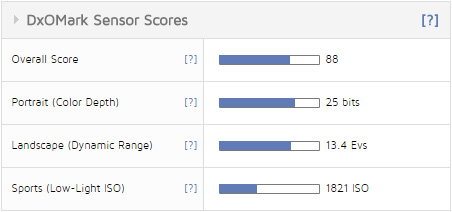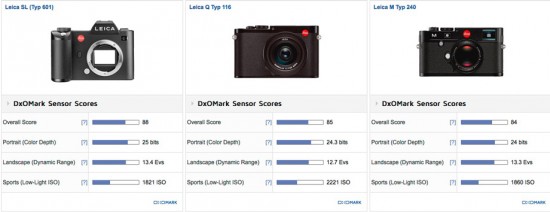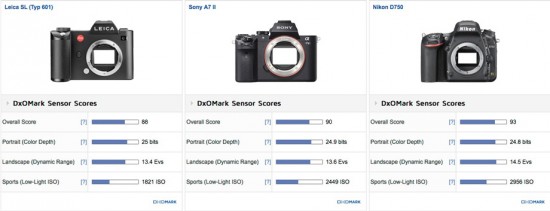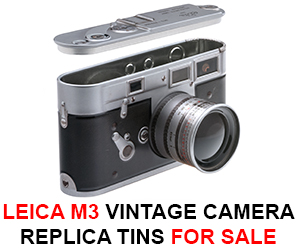

DxOMark published their test results from the Leica SL Typ 601 camera – as you can see the SL offers a slightly better dynamic range compared to the M 240 and the Q, something Louis mentioned in his SL review:
Leica seems to have set up the SL sensor to offer better dynamic range around base ISO, which might have sacrificed some high ISO performance when compared to the Q, because 12,500 ISO is not as usable as it was on the Q. The SL has the potential to be sharper and has greater dynamic range than my M240 at low ISO, but I still would greatly prefer my Q and M240 when walking around a city at night.
More from DxOMark’s test results:

Leica SL (Typ 601) vs Leica Q Typ 116 vs Leica M Typ 240 comparison
Compared with its siblings, the $7250 rangefinder Leica M and the $4250 fixed-lens compact Leica Q, the new Leica SL achieves an incremental 3-point lead over the latter and four points over the 21012 Leica M. Much of the overall improvement over the Leica Q is achieved by lower base ISO setting (ISO50) and a lower SNR, which in turn accounts for the increased color sensitivity of 25 bits. Indeed, all three share similar results for color sensitivity when they overlap in ISO sensitivities. In terms of dynamic range, this differs slightly, with the Leica SL and Leica Q sharing similar results. Both models show superior dynamic range over the Leica M at high ISOs, but at base, all three share a similar 13-stop dynamic range. Both the Leica SL and Leica Q have relative ISO invariance by comparison, and with it, a boost in dynamic range at around ISO400 that equates to almost a +2 EV advantage at ISO1600. Despite the lower noise floor, low-light scores are comparable, though the Leica Q has a slight advantage in our tests, equivalent to just +0.25 EV.
Leica SL (Typ 601) vs Sony A7 II vs Nikon D750 comparison
Comparing the Leica SL with two rivals that are capable of delivering a similar-sized 16-bit TIFF file, the Sony A7 II and Nikon D750, the Leica performs very competitively. In fact, overall it’s exceptionally close to the Sony and not far behind the Nikon, which has one the best-performing full-frame 24-Mpix sensors in our database.
In terms of color depth, the Leica SL is more or less on par with both throughout the ISO range, though the Leica’s lower base ISO of 50 helps its summary scores somewhat. That’s not to say it doesn’t have the highest-measured color sensitivity, but as always, it pays to look at the results presented in our graphs.
As for dynamic range, the Leica SL practically matches the Sony A7 II, though the Sony has around 0.5-stop extra dynamic range at ISO100 and around +0.3 EV advantage in low light. But that’s only a slight lead, and the extra dynamic range wouldn’t be noticeable at other settings.
Nikon has extracted the most from its sensor, and the Nikon D610 ranks alongside the D750 as class-leading at 24-Mpix. Nevertheless, with just 5 points in it overall, Leica is closing the gap that once existed in sensor dynamics between high-grade cameras and more mainstream models.
While color depth is on par with the Leica SL, the Nikon D750 has just over a stop (+1.1EV) wider dynamic range at ISO100, falling to just under that at IS200. By ISO400, the advantage in dynamic range has eroded, though Nikon maintains around a +0.5 EV lead in our low-light score.
DxOMark’s conclusion:
Although the Leica Q’s sensor performance hinted at the direction Leica was taking, the Leica SL sensor improves on that. Such improvement might be only in some small way, but it is quantifiable. With impressive still capability surpassing that of many high-end DSLRs, and with access to Leica’s huge range of top-drawer optics with a range of optional adapters, the Leica SL is a compelling choice, particularly for those who already own a number of Leica lenses. The Leica SL is not cheap, but then engineering at this level never is. Compared with the Leica M, there’s not much in it —indeed, it is even cheaper than a newer M-P at $7950, and that’s before taking into account the extra $570 for the Leica Visoflex EVF2. Given the advantages of the built-in viewfinder for focusing, particularly off-center, the SL may even be the better bet.

















